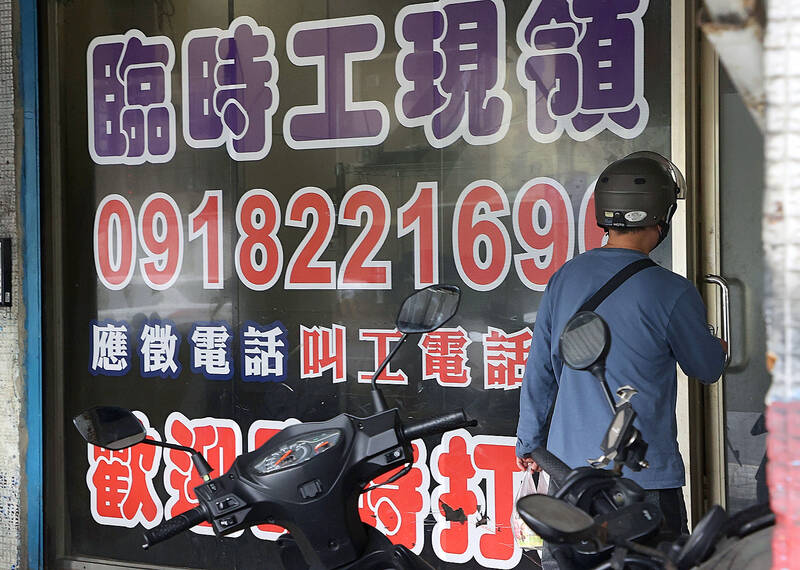The nation’s unemployment rate last month stood at 3.3 percent, marking a 0.02 percentage point fall from the previous month to the lowest in 25 years, as fewer people quit or lost their job to business downsizing or closures, the Directorate-General of Budget, Accounting and Statistics (DGBAS) said yesterday.
The jobless rate after seasonal adjustments was 3.37 percent, down 0.01 percentage points from December last year, it said.
“Overall indicators suggested a stable employment market in Taiwan,” Census Department Deputy Director Tan Wen-ling (譚文玲) said.

Photo: CNA
Tan said unemployment is likely to rise moderately this month due to post-holiday job transitions and a drop in temporary positions now that the Lunar New Year holiday is over.
The total number of unemployed individuals reached 396,000, down by 3,000 from one month earlier, after people who quit dropped by 2,000, the DGBAS said in a report.
The number of first-time jobseekers and job losses linked to business contractions and closures also declined by 1,000 each, it said.
By educational breakdown, people with university diplomas had the highest unemployment rate at 4.45 percent, followed by people with high-school or vocational-school education at 3.1 percent, the report said.
Those with graduate degrees had an unemployment rate of 2.7 percent, while people who had only completed junior high school or below had the lowest unemployment rate at 2.08 percent, it said.
Demographically, people aged between 20 and 24 had the highest unemployment rate of 11.14 percent, many of whom are first-time job seekers and need more time adjusting to the workforce, the report showed.
People aged between 15 and 19 had the second-highest unemployment rate of 7.94 percent, followed by the age group between 25 and 29, it said.
People older than 35 had an unemployment rate of below 2.5 percent, and the 45-to-65 age bracket consistently had the lowest jobless rate at 2.19 percent, it added.
The number of underemployed workers — those who work fewer than 35 hours a week because of economic reasons — totaled 109,000, a 15.94 percent fall from the previous month, thanks to an increase in temporary hiring, the report said.
The potential labor force — those not currently in the workforce, but willing and ready to work — stood at 138,000, shrinking by 5,000 from the preceding month, it said.

Taiwan’s long-term economic competitiveness will hinge not only on national champions like Taiwan Semiconductor Manufacturing Co. (TSMC, 台積電) but also on the widespread adoption of artificial intelligence (AI) and other emerging technologies, a US-based scholar has said. At a lecture in Taipei on Tuesday, Jeffrey Ding, assistant professor of political science at the George Washington University and author of "Technology and the Rise of Great Powers," argued that historical experience shows that general-purpose technologies (GPTs) — such as electricity, computers and now AI — shape long-term economic advantages through their diffusion across the broader economy. "What really matters is not who pioneers

In a high-security Shenzhen laboratory, Chinese scientists have built what Washington has spent years trying to prevent: a prototype of a machine capable of producing the cutting-edge semiconductor chips that power artificial intelligence (AI), smartphones and weapons central to Western military dominance, Reuters has learned. Completed early this year and undergoing testing, the prototype fills nearly an entire factory floor. It was built by a team of former engineers from Dutch semiconductor giant ASML who reverse-engineered the company’s extreme ultraviolet lithography (EUV) machines, according to two people with knowledge of the project. EUV machines sit at the heart of a technological Cold

TAIWAN VALUE CHAIN: Foxtron is to fully own Luxgen following the transaction and it plans to launch a new electric model, the Foxtron Bria, in Taiwan next year Yulon Motor Co (裕隆汽車) yesterday said that its board of directors approved the disposal of its electric vehicle (EV) unit, Luxgen Motor Co (納智捷汽車), to Foxtron Vehicle Technologies Co (鴻華先進) for NT$787.6 million (US$24.98 million). Foxtron, a half-half joint venture between Yulon affiliate Hua-Chuang Automobile Information Technical Center Co (華創車電) and Hon Hai Precision Industry Co (鴻海精密), expects to wrap up the deal in the first quarter of next year. Foxtron would fully own Luxgen following the transaction, including five car distributing companies, outlets and all employees. The deal is subject to the approval of the Fair Trade Commission, Foxtron said. “Foxtron will be

INFLATION CONSIDERATION: The BOJ governor said that it would ‘keep making appropriate decisions’ and would adjust depending on the economy and prices The Bank of Japan (BOJ) yesterday raised its benchmark interest rate to the highest in 30 years and said more increases are in the pipeline if conditions allow, in a sign of growing conviction that it can attain the stable inflation target it has pursued for more than a decade. Bank of Japan Governor Kazuo Ueda’s policy board increased the rate by 0.2 percentage points to 0.75 percent, in a unanimous decision, the bank said in a statement. The central bank cited the rising likelihood of its economic outlook being realized. The rate change was expected by all 50 economists surveyed by Bloomberg. The